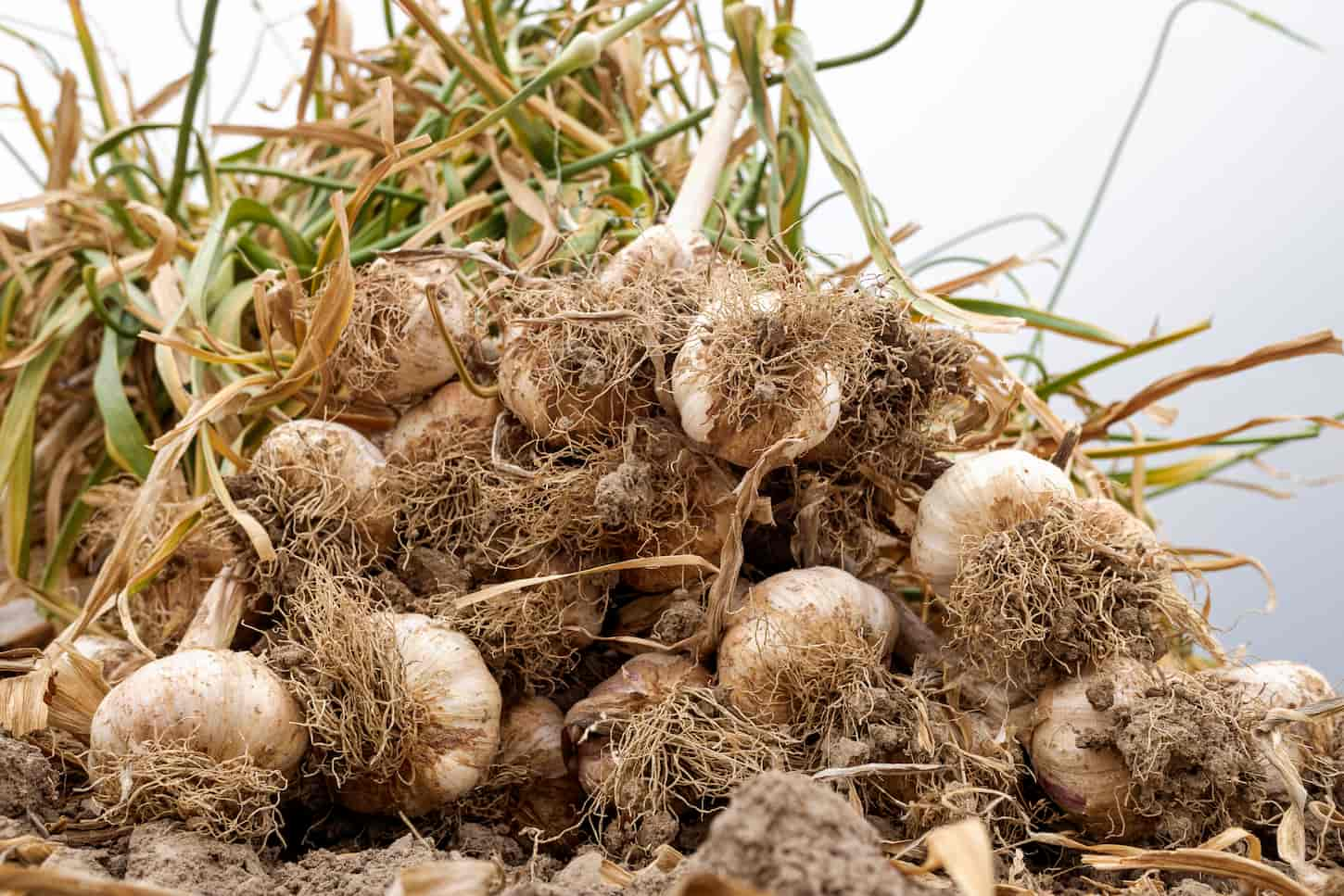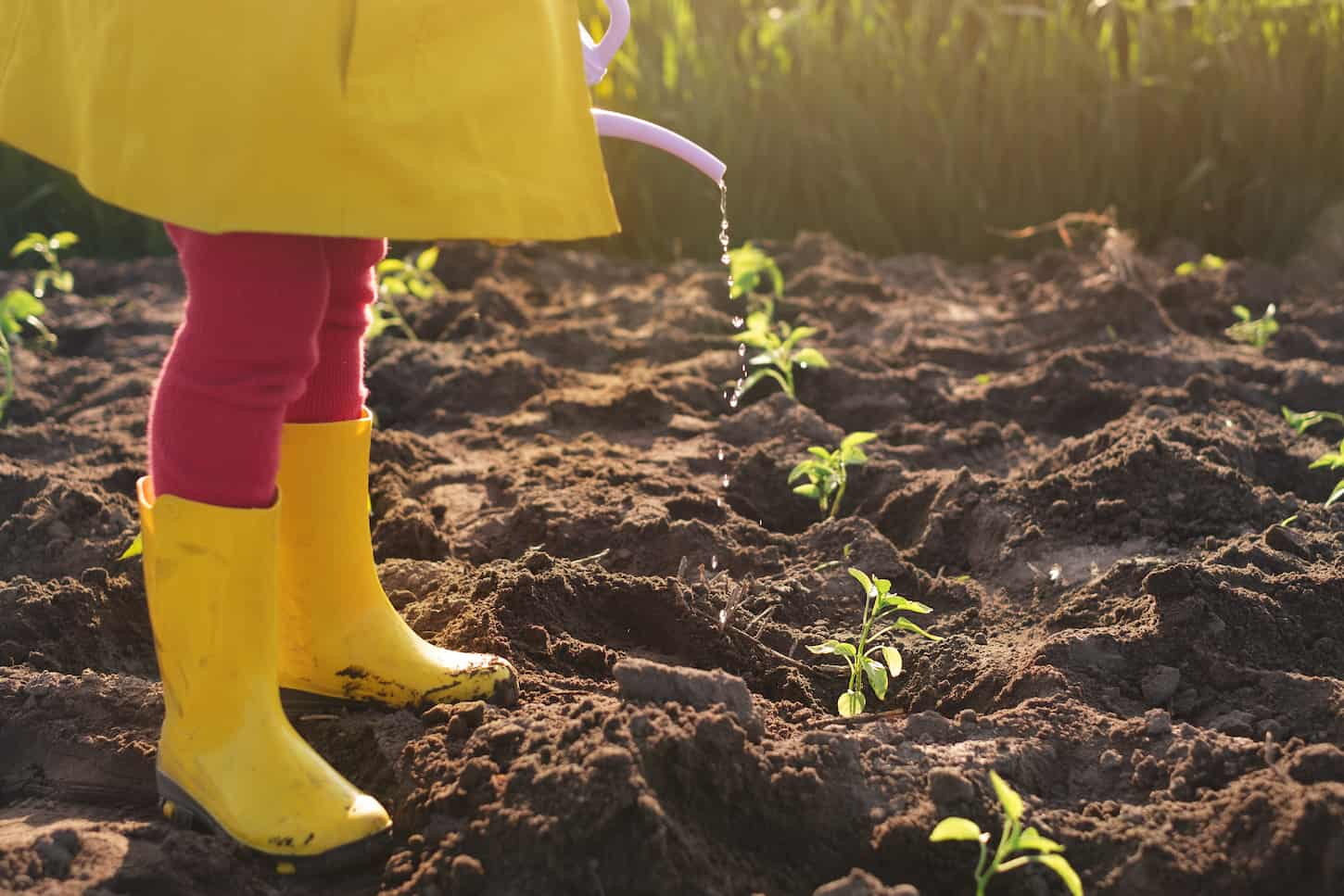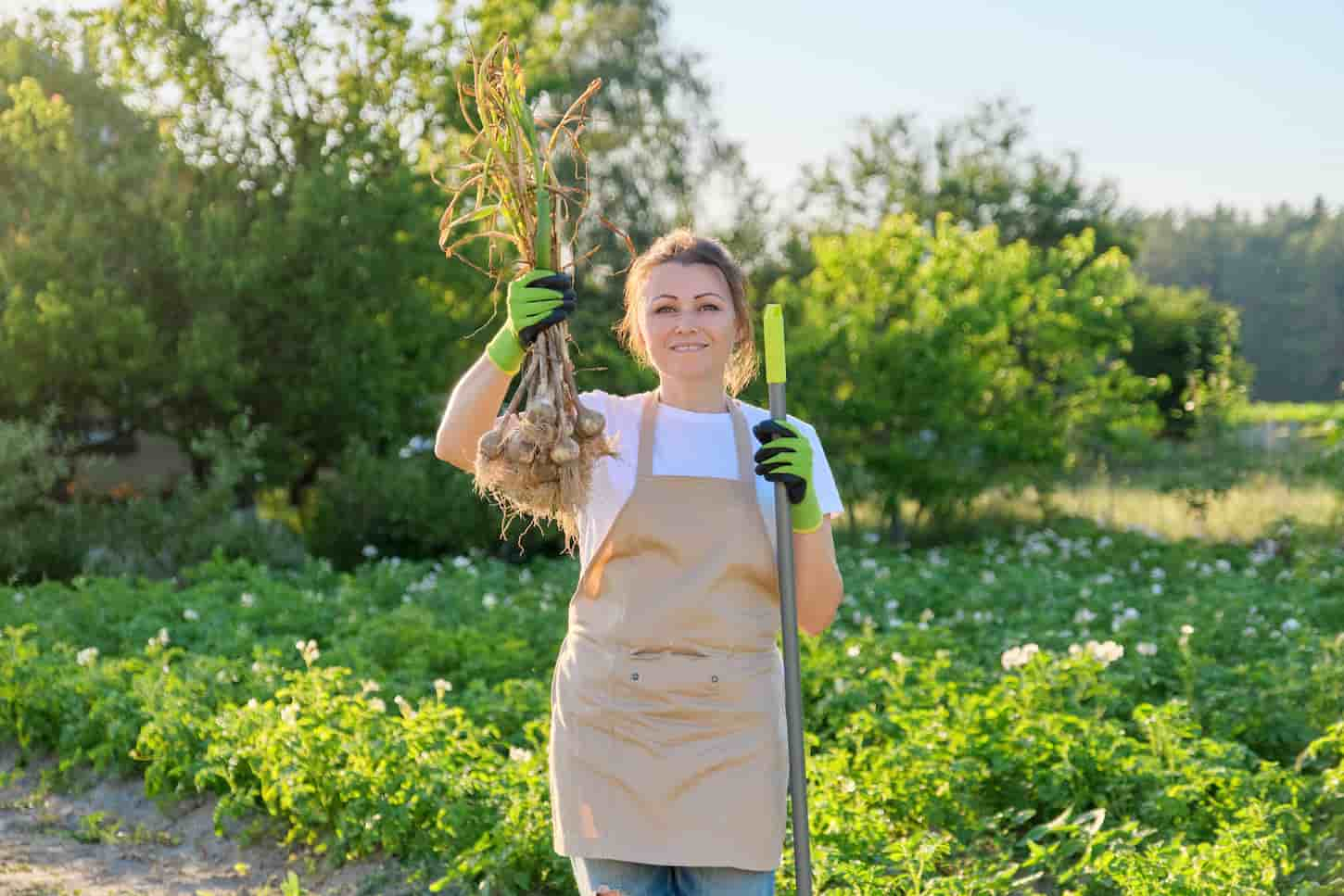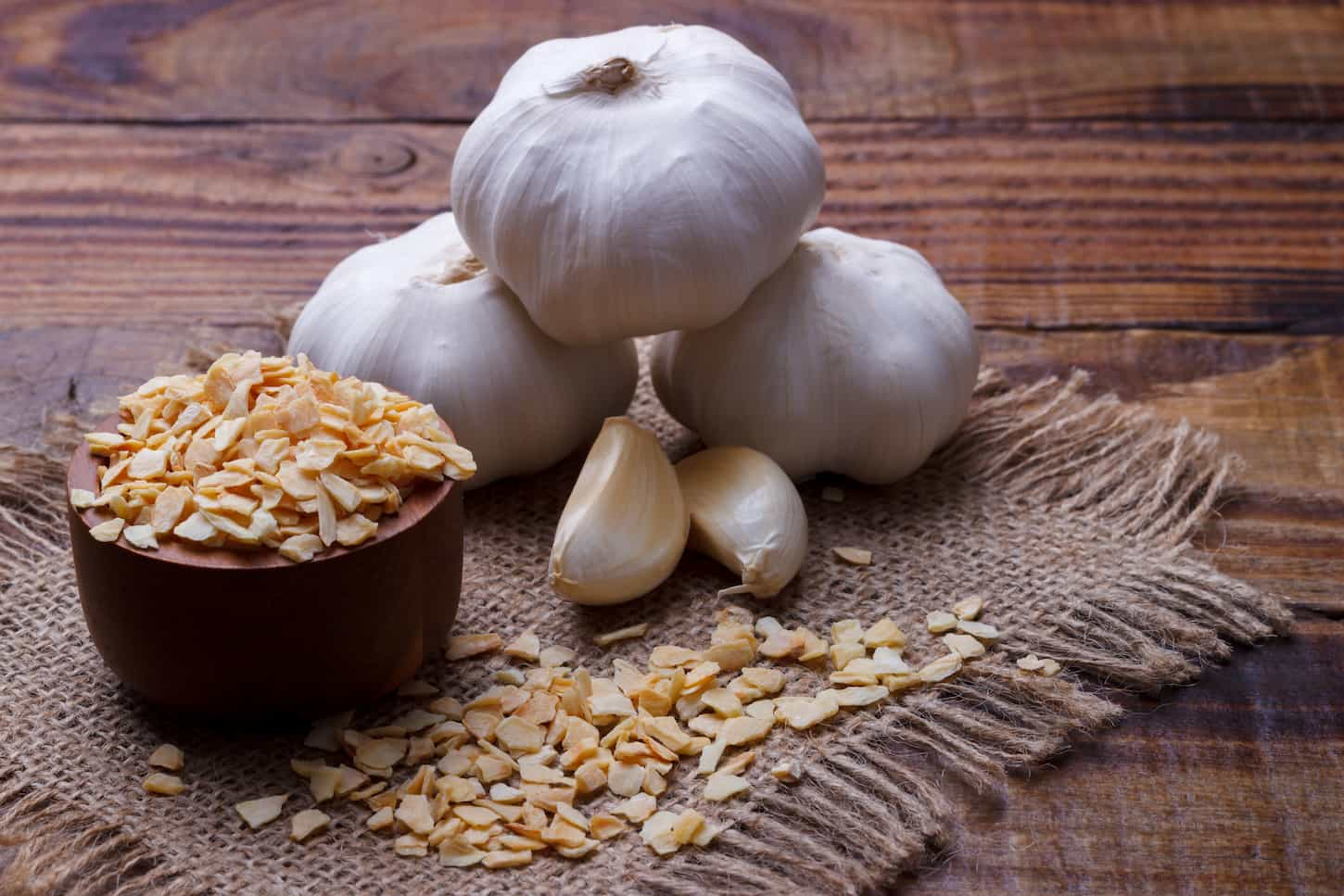Growing garlic is a must for any garden, or at least it’s a must for any gardener who enjoys eating garlic on anything. Fresh garlic tastes so much better. But for years, I struggled to understand why my garlic didn’t do well. Thankfully, some research and adjusting how I tried to grow garlic has saved our savor.
Ready to learn all about growing garlic? Read this complete guide and save yourself the hours of failed harvests, research, pain, and scientific papers that I read so you don’t have to.

Garlic Plants: Quick Info and What it is
Garlic is also known as Allium Sativum. It’s a perennial plant that’s part of the onion family, along with chives, leeks, and shallots. Garlic is native to central Asia but also grows wild in Europe. Plants can grow up to 2 feet tall, and it takes 240 days for their bulbs to mature.
The bulb consists of up to 20 cloves, and we use these as a staple ingredient to flavor the most savory dishes. Garlic has lots of health benefits due to its sulfur compounds. It’s also rich in nutrients, such as B6, vitamin C, selenium, copper, calcium, potassium, phosphorus, and iron.
As well as this, garlic is antimicrobial and antifungal. It can boost your immune system, and it may reduce the length of a cold if you do catch one.
High doses of garlic may help to reduce high blood pressure and improve cholesterol levels. It’s a strong antioxidant, and it’s good for your brain health too. So, it certainly is a useful plant to have in your garden.
What are the Different Types of Garlic?
There are two main types of garlic, known as softneck and hardneck garlic. Hardneck garlic has a pungent flavor and enjoys cooler climates, while soft neck garlic has larger bulbs and a milder taste.
Below, we’ll take a closer look at the two.
Hardneck Garlic
Hardneck garlic is the hardest type of garlic. It produces scapes (flowering stalks) in the early summer. And you must remove these so that your garlic uses its energy to bulb instead of a flower. Scapes are delicious, so don’t throw them away. Use them in dishes the same way you’d use spring onions or chives.
Hardneck garlic produces one layer of cloves that sit around the stem, and they don’t store as well as other varieties.
Softneck Garlic
Soft neck garlic prefers to grow in warmer climates. They produce large bulbs with two or three layers of cloves. Soft neck garlic is the one you usually find in supermarkets. This is because they store better than their hardneck counterparts.
Softneck garlic doesn’t produce scapes or flowers.

Garlic Planting Tips
Strong, robust garlic plants require a good start, as they are less likely to fall over or have other issues during the season. For the best results, buy and start cloves from your garden center rather than the local supermarket, as they will be better suited for the local climate.
Plant your garlic in the autumn between September and November. Garlic needs to develop its roots before the ground freezes. And you should give them a layer of mulch over winter.
Your garlic will grow over the winter and can be ready to harvest in about 240 days (sometime between April and July, depending on when you planted it).
Break the bulb open a few days before you plant the cloves but leave the skin intact on each clove. Place the cloves into the earth with the wide side pointing down, and the narrow tip facing the surface.
Plant your garlic 2 inches deep into the earth and in rows 2 to 4 inches apart. You can also grow garlic in containers. But containers must be at least 15 inches wide to accommodate 3 cloves.
How Long Does Garlic Take to Grow?
Garlic can take 7 to 8 months to grow, while some varieties take as long as 10 months to grow. Garlic is a perennial that can be left to grow in the soil almost indefinitely over 12 to 15 months while being harvested as needed.
Growing garlic as a perennial is slightly different, as it means adapting a mindset where you do less work. It also may mean switching from a softneck to hardneck garlic variety. That way, you can get the benefit of harvesting garlic scapes as needed, and pretty much ignoring the rest of the garlic plant to let it grow for the first several years.
After that, you’ll have garlic scapes that will dry down to miniature cloves, which can be used as seeds or eaten like normal cloves.
From there, you can also divide plants in spring for fall planting in the following years if you’d prefer.
With perennial garlic, you’ll have enough garlic for all your culinary needs year-round.
How Much Sun Does Garlic Need?
Garlic does best in full sun, with 6 to 8 hours of sunlight. Garlic can also grow in shadier areas with less than full sun, though the bulb cloves will not be as large. The amount of sunlight will only affect clove size and will not affect the flavor.
Garlic also does best in loose, earthy soil. If there’s too much clay, make sure you amend the soil to loosen it up so that your garlic will have room to expand as it grows.

How Often Should You Water a Garlic Plant?
Water garlic regularly (every 3 to 5 days) from May through to June when they’re bulbing. Most gardeners can decrease or even stop watering their garlic altogether in the weeks leading up to harvest.
However, every garden plot is different, and there are lots of different factors that will dictate how often to water garlic.
Your garlic will need more water in hot weather and less water during cool weather and rainfall. And plants in raised beds and containers will need more water because they lose moisture faster.
The best way to tell if your garlic plants need water is by feeling the earth. If the top inch or two is dry, your plants need a drink. If it’s moist still, let them dry out a bit before you give them some water.
Ideally, water your garlic with a drip irrigation system. This will deliver small amounts of water at a steady rate. It keeps the water off the leaves and is the most efficient way to water any plant. If you water your garlic by hand, do it slowly and gently in the morning or late afternoon.
How Do You Treat Garlic Pests and Diseases?
Garlic is traditionally used as a pest deterrent, but it still can be affected by insects like mites, maggots, thrips, rot, mold, blotch, blight, and soil issues from fungus. The best way to treat the issue is to first identify the issue for proper treatment.
Here are the common insects that afflict garlic.
- Thrips are tiny, thin insects that eat garlic leaves. The munched-on leaves may turn silver before twisting and dying. Thrips nest where the leaf meets the bulb. Mulching plants, washing them with stiff water, and using natural biological control can help minimize thrips.
- Maggots are white worms that feed on rot (in the roots, bulbs, or seedlings). Crop rotation and avoiding a huge buildup of organic matter are the only ways to prevent or treat maggots. Infected plants should be destroyed.
Here are some of the common diseases that affect garlic.
- Neck rot is a fungal disease that causes the bulb to turn to watery mush in storage. The only way to prevent neck rot is to reduce watering before harvest and to carefully cure the bulbs before storage.
- Rust happens when your garlic is watered overhead, and the leaves get red spots. Change to drip irrigation to avoid this issue in the future.
- Root rot is a more severe issue related to improper watering and/or inadequate crop rotation. Remove the affected plants. Make sure to rotate crops.

Does Garlic Need to Be Fertilized or Mulched?
Garlic can benefit from being mulched to reduce weeding and from fertilizer rich in nitrogen (21-0-0) in mid-April and late May.
If you’re using a chicken manure compost, then you’re in luck. All that manure is rich in nitrogen and your garlic will love you.
How Do You Know If You’ve Overwatered Garlic?
Overwatered garlic will have soft, squidgy, yellowing leaves. So, if the garlic has these symptoms, stick a finger in the soil. If the soil is wet, odds are that the garlic is overwatered.
If you don’t fancy sticking your fingers in the soil, you can use a cocktail stick or a humidity gauge to check the moisture levels. Push the stick into the soil, if it comes out dark brown, this means there’s lots of moisture in the soil. If the color doesn’t change, this means the soil is dry.
Overwatered garlic may also develop edema on its leaves, and in severe cases, the earth may become moldy and start to emit an unpleasant smell. If this is the case, dig up a bulb to make sure your garlic isn’t rotting.
How Do I Know When My Garlic is Ready to Harvest?
Garlic is usually ready to harvest from June through August. It’s ready when the tops will yellow, start to droop, and then the garlic will fall over.
To find out if your garlic is ready, dig up one bulb first. If it’s well-developed with thick, papery skin, it’s time to harvest. But, if the skin is thin and breaks easily, the garlic isn’t ready, so you need to leave them a while longer.
Generally speaking, don’t leave your garlic too long, because once they’re mature, the bulbs will split underground and become contaminated with soil. If the leaves of your garlic plant are dry and crispy, this is a sign that you’ve left your garlic too long.
However, in some areas, garlic can stay in the ground for a long time, if it’s cool or cold enough. We’ve left garlic in the ground as long as through the next winter, and it’s been fine. Sometimes, it’s easier to let it “store” there than to bring it inside!
If you want to copy us, please do so with this warning: always check long-planted garlic first before eating it. It’s safer to only eat properly planted and harvested garlic. When in doubt, play it safe. Food-borne illness isn’t worth the trouble.
Harvesting pro tip: When you remove the garlic from the earth, don’t just pull them up by hand. It’s better to ease them out gently with a small gardening fork to prevent any damage. Once you’ve harvested your garlic, you need to dry it out before you store it.
Once you’ve harvested and dried your garlic, it’s common practice to pick the best-looking bulbs to become your seed garlic for the next growing season. That way, you’ll have more garlic next season, too!

Why Are My Garlic Plants Falling Over?
Garlic plants normally “fall” over near harvest, though other reasons for falling garlic include a nutrition deficiency (related to water, sunlight, or micronutrients), pests, or recent severe weather.
Thankfully, I’ve got a whole article that will walk you through each of those reasons – and what to do about each one. So make sure you give it a read next by clicking right here: Why Do Garlic Plants Fall Over? (7 Reasons and Tips).
How to Store Garlic
Garlic can be stored in many ways: in the ground, dried in the pantry, freeze-dried, dehydrated, pickled, etc. The best way to store garlic is in whatever manner it’s best enjoyed by the family storing the garlic.
Ready to store the garlic? Here are our favorite ways to store garlic.
Drying Garlic for Storage
Before you dry garlic, remove the dirt but leave the roots and leaves intact. Hang your garlic upside down from some string or put them on an airing rack to dry. And leave them in a cool, dark, dry place with good ventilation for a few weeks.
You’ll know your garlic is dry because it will have papery skin, dry roots, and a hard root crown, and the bulb will crack open easily.
General Storage
Once your garlic is dry, remove the roots and leaves before you store it. For optimum storage, keep it in a cool, dark, dry place, with a temperature of around 40 degrees Fahrenheit. Your garlic can last till the following harvest if you store it correctly, and the flavor will increase with age.
Save your largest bulbs for replanting the following season. The largest, healthiest cloves produce the most robust plants. And eat your hardneck garlic first because these don’t store as well or long as softneck ones.
Garlic Prep for Freeze-Drying
Prefer to freeze-dry your garlic? Awesome. It can still be dried first, though it doesn’t have to be.
After you clean it, go ahead and slice, dice, or prepare it in your favorite method before pre-freezing it as part of the freeze-drying process.
Pre-freezing garlic is totally optional, but it is a nice way to speed up the overall freeze-drying process when you’ve got lots of other things waiting to be freeze-dried anyway.
Then go ahead and freeze-dry the garlic. Make sure you don’t freeze-dry it with anything that you don’t want to come out with a garlic flavor, though. Stick to garlic and foods you want to be infused with that lovely garlic flavor.
Dehydrating Garlic
Garlic can also be dehydrated after it’s been dried for storage. The downside to dehydrating garlic (beyond the usual drying) is that it is more labor-intensive than the usual drying process for not much extra benefit (at least in my experience).
So, if you’re wanting to dry garlic, my recommendation would be to dry it in the traditional manner by hanging it for several weeks.
The only time I’d resort to dehydrating it (in a dedicated dehydrator) would be if hanging it for several weeks wasn’t feasible – and you needed it dried quickly.

Pickling Garlic
Pickling garlic is also an option. Pickling uses vinegar, salts, and time to store the garlic for you. Some pickled garlic recipes are shelf-stable, while others are not. It depends on the recipe, the garlic used, and the process.
There are a ton of recipes available online. I haven’t tried any of them because pickling garlic isn’t our thing. However, make sure that you find an appropriate recipe. You may need to try several to find the one that you like best.
If you don’t know where to start, I recommend starting with All Recipes or America’s Test Kitchen. They’re both super reliable and awesome recipe sites. Of the two, I recommend you check out America’s Test Kitchen first, but it does require a paid subscription. We subscribe to it and highly recommend it. I am not an affiliate with them (they don’t have an affiliate program), but they are my favorite recipe website.
All Recipes can be more hit or miss, but they’re still my second choice for recipe sites. And they’re free, which is awesome.
Next Steps
Garlic really is amazing. It’s one of the essential plants every gardener should grow because it flavors so many of our foods. Plus, it’s just delicious.
Now that you know more about growing and storing garlic, make sure you read this article next: Freeze Dry VS Air Dry: 8 Differences that Matter. It’ll help you in your food storage efforts with garlic.
Resources
Learning from your own experience is essential, but learning from others is also intelligent. These are the sources used in this article and our research to be more informed as homesteaders.
- “Common Onion and Garlic Pests.” Utah State University, extension.usu.edu/pests/ipm/notes_ag/veg-list-onion-garlic. Accessed 6 Dec. 2021.
- “Garlic in the Garden.” Utah State University, 18 Oct. 2021, extension.usu.edu/yardandgarden/research/garlic-in-the-garden.
